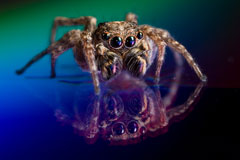Caution: Objects May Appear Larger Than They Really Are
by
I am terrified of cockroaches. The high-pitched-screaming, jumping-on-a-chair, shaking-in-my-boots kind of terrified. Before my department moved into the lovely facility I work in now, the labs were located in a rather dilapidated building that was infested with South American cockroaches. They usually hung out in the autoclave room, but every so often they would venture out for a joyride in the elevator. After discovering this the hard way, I exclusively took the stairs.
Phobias like this are very common, and for the most part are harmless. But in some cases they can be extremely detrimental. Agoraphobia prevents people from leaving their homes and living a normal life. Aichmophobia (or trypanophobia) refers to the fear of needles, and can lead to people avoiding the medical care that they need. Understanding the basis of these morbid fears is crucial to finding a way to help the people living with them.
In a paper published this week in the Journal of Anxiety Disorders, researchers at the Ohio State University showed that arachnophobic individuals have an overblown idea of the size of the spiders they’re so afraid of.
In the study, the authors placed individuals in a room with a tarantula. The spider was enclosed in a glass case, and over time the subject was asked to approach the spider. Once they reached the case, they then used an eight-inch probe to get the spider to move around the tank. Throughout the task fear was measured on a scale of 0-100.
When asked to estimate the size of the spider from front leg to back (by drawing a line on a piece of paper) there was a strong correlation between fear and an exaggeration of the spider’s size. Those that were afraid genuinely thought the spider was larger than it really was.
Certainly this research is interesting, but I am left with the question: Why does something appearing larger make it more terrifying? Especially since the perceived size is still relatively small, and the spider is highly unlikely to maim or even kill you. That said, the thought of a giant cockroach is giving me the heeby-jeebies right now.

Sweet dreams- see you tonight under the covers.
Lead author on the study Michael Vasey has an idea: “We already knew fear and anxiety alter thoughts about the feared thing. For example, the feared outcome is interpreted as being more likely than it really is. But this study shows that even perception is altered by fear. In this case, the feared spider is seen as being bigger. And that may serve as a maintaining factor for the fear.”
So whereas the spider appearing bigger may not be what is triggering the arachnophobia, it is exacerbating it. This leads a person to avoid spiders (or needles, or large spaces) and therefore the phobia propagates inside their mind.
But perhaps there are some more positive outcomes from this research. I’m sure there a few fellows out there wondering if this misconception of size is dependent on phobia, or could perhaps be transferred to other, more, ahem, pleasurable situations. I will keep my eye on the literature, chaps.
.
Katie Pratt is a graduate student in Molecular Biology at Brown University. She has a passion for science communication, and in an attempt to bring hardcore biology and medicine to everyone, she blogs jargon-free at www.katiephd.com. Follow her escapades in the lab and online on Twitter.
.
Be the first one to mind the gap by filling in the blank as a comment and get your name in the blog along with a sweet new BenchFly mug!
UPDATE: Congratulations to Sabri Bora Erdemli – winner of this week’s Mind the Gap!
About the winner: Sabri is the co-Founder of PhD2Consulting and full time graduate student at Johns Hopkins University School of Medicine trying to address global health problems.
About the prize: In addition to fame and glory beyond their wildest dreams, winners receive our new hot-off-the-presses large (15 oz) BenchFly mug to help quench their unending thirst for scientific knowledge… or coffee.

Miss a previous edition of Mind the Gap? Shame on you! Don’t worry – we’ve got you covered:
Facebook Updates: The Good, The Bad, and The Vague
Scared of Dropping the Soap? Worry No More.
A Social Network for Food: Why Won’t Vanilla Friend Garlic?
I’d Rather Die Fat and Young than Old and Skinny
Look Into My Wide, Vacant, Eyes
Sweet Relief: How Sugar May Help Reverse Climate Change
Laughter Really is the Best Medicine
All Work and No Play Makes Katie RSI Prone
Sexual Identity and Autocrine Stimulation: Oh, To Be Teenage Yeast
On Wine, Sunburns and the Tendency of Headlines to Mislead
Which Came First: The Opossum or the Snake?
Pigeons Know a Crazy Woman When they See One
To Boldly Go Where No Worm Has Gone Before
Another One Bites the Dust: Rinderpest Eradicated
Scientists Just Wanna Have Fun (Like Uncaged Monkeys)
Mosquitoes Eating You Alive? Cheesy Feet Could be the Problem
.
.



@PhD2Consulting
wrote on February 24, 2012 at 2:24 pm
Trypanophobia
alan@benchfly
wrote on February 24, 2012 at 2:36 pm
We've got a winner!
Veena Thomas
wrote on February 24, 2012 at 2:26 pm
Trypanophobia
Donna Foster Myer
wrote on February 24, 2012 at 8:18 pm
It seems to me that another aspect to many phobias is number. I, for example, am not terribly afraid of cockroaches. Yet … in grad school one of my friends was doing nerve transmissiono work on cockroaches & kept inviting me to her lab. Well – I went ONCE. Her doctoral advisor propogated cockroaches – in this big table top sized lucite box – about 12 inches high – were a gazillion cockroaches. Even today – which is some 43 years later kiddies – just writing that has my skin crawling. I find that I react the same way to ants or flocks of gulls at the beach. One little fishie bimping against my toes is fascinating but many more & I see myself dashing for the beach with my knees coming WAY out of the water. Wonder what the connection is between mental increase in size of one frear causing critter and true increase in numbers of normal size critters. Even contemplating ME + "many" cows or "many" rabbits brings forth a strong desire to flee …. ahhh – bye bye now.